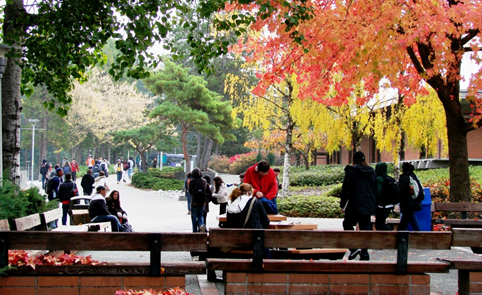Morphing Virtual into Reality - Building the “Virtual College”
Published by: WCET | 8/23/2012
Tags: Managing Digital Learning, Marketing, Online Learning, Student Success, Technology, Virtual/Augmented Reality
Published by: WCET | 8/23/2012
Tags: Managing Digital Learning, Marketing, Online Learning, Student Success, Technology, Virtual/Augmented Reality
Last fall, I had the pleasure of meeting President Lee Lambert and Ann Garnsey-Harner of Shoreline Community College after they presented on their ambitious plans to create a virtual college. I was taken by the visionary leadership of President Lambert and the yeoman’s (yeoperson’s?) work of Ann Garnsey-Harter in using an open, inclusive planning process to create their new ‘virtual college.’ Here’s their story…
Russ Poulin
This July, the Shoreline Virtual College, a comprehensive community college just north of Seattle, went from project to product, from ethereal to earthly, from dream to … well, you get the idea.
It is absolutely a work in progress, but it also has progressed to absolutely working.
The Vision
Our effort had an inauspicious beginning. At a brown-bag, all-comers campus lunch on Aug. 26, 2010, our president, Lee Lambert, said, ““Technology can provide the platform to build a college within a college.” Then, using the analogy of a store that has a physical location to serve some customers, but can serve many more with an online store, he added: “What if we had a virtual store?”

And so it began.
Creating a ‘Blueprint’
By December, I was drafted to co-chair a new “Virtual College Leadership Team,” and given the fast-track goal of producing a recommendation to the president 90 days later. The team was hand-picked from across the campus for their specific skills and perspectives. After a few initial full-group meetings, we decided that a divide-and-conquer approach was our only hope of meeting the deadline. We used a project wiki to organize ourselves, collaborate, and to share what was going on with our campus. The word “brutal” comes to mind when thinking back to the resultant schedule of meetings and work, but the word “rewarding” pops up when I think of what was accomplished.
We persevered and on Wednesday, March 9, 2011, delivered a 92-page “Blueprint for a Virtual College: Report to the President’s Senior Executive Team” to President Lambert and his executive team.
 The Blueprint’s conclusions aren’t radical, but because we looked into every nook and cranny of the online educational experience, we’re confident they provide a thoughtfully solid foundation for this college at this time. We said the college should take an “approach that will build upon the College’s existing strengths: offering high quality online instruction at an affordable price. … Using this incremental approach, the immediate recommended goal is to improve existing online instructional offerings and to package them comprehensively, and – equally if not more importantly – to address internal process barriers in the area of student services.”
The Blueprint’s conclusions aren’t radical, but because we looked into every nook and cranny of the online educational experience, we’re confident they provide a thoughtfully solid foundation for this college at this time. We said the college should take an “approach that will build upon the College’s existing strengths: offering high quality online instruction at an affordable price. … Using this incremental approach, the immediate recommended goal is to improve existing online instructional offerings and to package them comprehensively, and – equally if not more importantly – to address internal process barriers in the area of student services.”
Shoreline was already a pretty big player in online education through our existing eLearning program. We saw opportunities to grow in numbers of students served and the quality of the educational experience. We also saw that our student services areas – particularly the enrollment-related areas – were built for the person who can physically come to our campus. We knew that to be successful, we’d have to meet more than students’ online educational expectations, we’d also have to meet their online consumer expectations.
We’re moving ahead in both areas.
Now, We’re Implementing
For the academic experience, we’re currently using the latest version of Blackboard and their mobile-device platform. In making that choice we were mindful of two things: 1) The Washington Community and Technical College state system was Angel-based and about to solicit bids for a new learning management system, and 2) President Lambert wanted this done yesterday. Blackboard has been a valuable partner in this effort and any future decisions will be based on the best learning experience we can provide for our students.
We’ve also been working hard to optimize and standardize the online environment that students experience. Across our physical campus, our classrooms pretty much look and operate the same way. The instructor changes, the course content changes, but the chairs, desks, paint, light switches are all familiar. By working closely with our faculty, we are using the Quality Matters program to bring that same level of familiarity to our virtual campus.
Addressing the student services areas, including the consumer interface, is an ongoing challenge. Obviously, we needed processes that would meet students’ needs without requiring them to come to the physical campus. In short order, we also realized that such processes would benefit all students, whether they could come to campus or not. In truth, we already had such processes, but they were clunky, definitely not the path of least resistance. So, we’re working with vendors and our on-campus constituencies to build something that works for all. Our goal is to remove the process of becoming a student as one of the barriers to the life-changing education we know we are providing.
So, www.shorelinevirtualcollege.org is on its way. Our Public Information Office has launched advertising campaigns focusing on five of our 20 online degrees and certificates. We’re monitoring the contacts we get from the marketing efforts, closely watching enrollment numbers and holding our collective breath maybe just a little. We know there is much to improve, but we also know that “perfect” is an elusive goal that can get in the way of progress. While the Shoreline Virtual College is the result of many hands, perhaps the most important ingredient was leadership that was more interested in a strategy of “launch and fix.” For all the behind-the-scene details, please rea d through our project wiki.
d through our project wiki.
Ann Garnsey-Harter
Director of the Virtual College and eLearning Services
Shoreline Community College
agarnsey@shoreline.edu